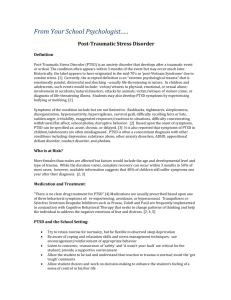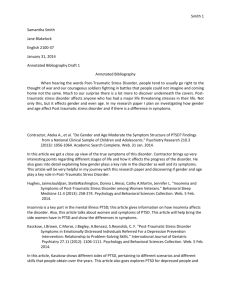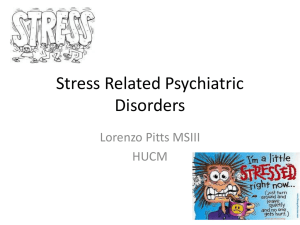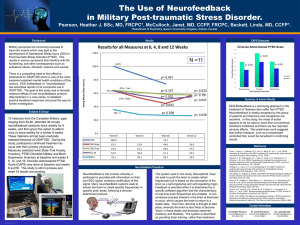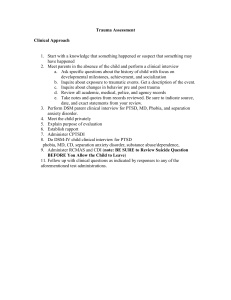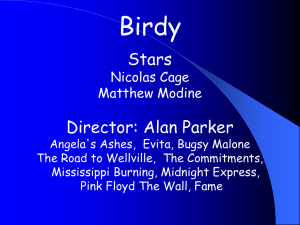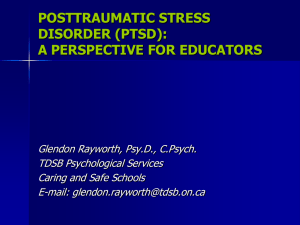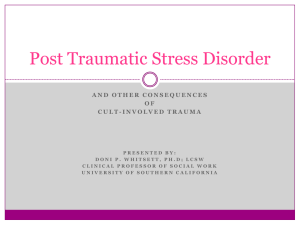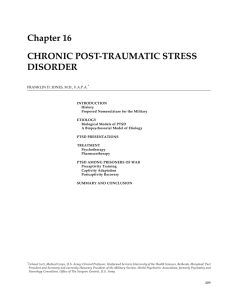File - Steven Youchnik
advertisement
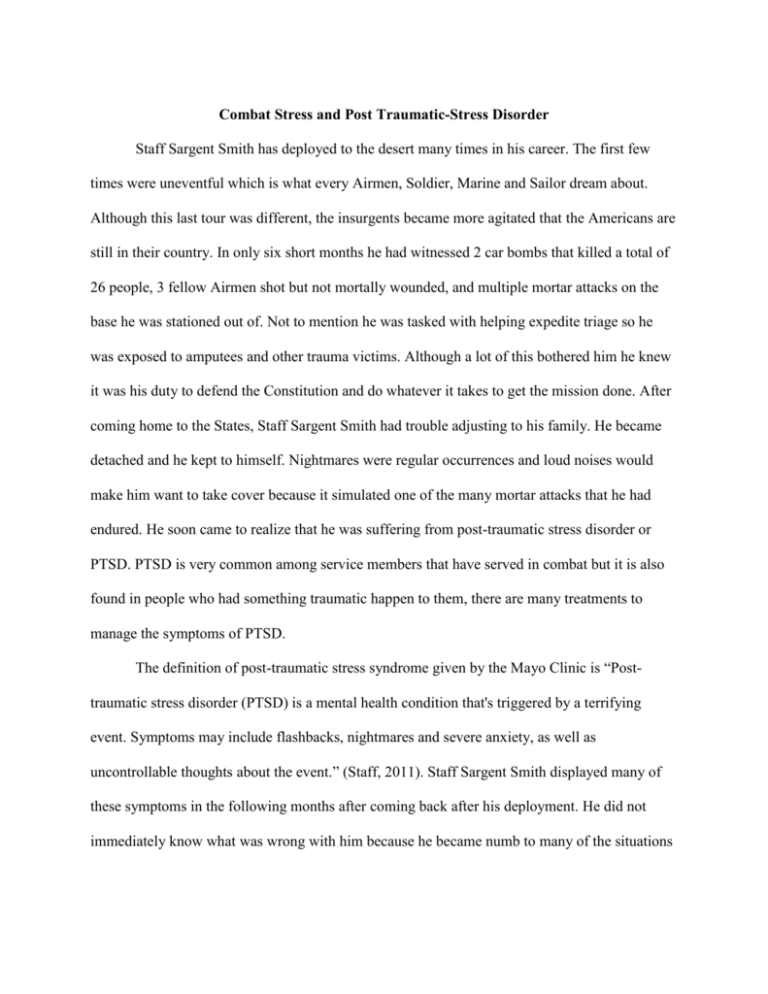
Combat Stress and Post Traumatic-Stress Disorder Staff Sargent Smith has deployed to the desert many times in his career. The first few times were uneventful which is what every Airmen, Soldier, Marine and Sailor dream about. Although this last tour was different, the insurgents became more agitated that the Americans are still in their country. In only six short months he had witnessed 2 car bombs that killed a total of 26 people, 3 fellow Airmen shot but not mortally wounded, and multiple mortar attacks on the base he was stationed out of. Not to mention he was tasked with helping expedite triage so he was exposed to amputees and other trauma victims. Although a lot of this bothered him he knew it was his duty to defend the Constitution and do whatever it takes to get the mission done. After coming home to the States, Staff Sargent Smith had trouble adjusting to his family. He became detached and he kept to himself. Nightmares were regular occurrences and loud noises would make him want to take cover because it simulated one of the many mortar attacks that he had endured. He soon came to realize that he was suffering from post-traumatic stress disorder or PTSD. PTSD is very common among service members that have served in combat but it is also found in people who had something traumatic happen to them, there are many treatments to manage the symptoms of PTSD. The definition of post-traumatic stress syndrome given by the Mayo Clinic is “Posttraumatic stress disorder (PTSD) is a mental health condition that's triggered by a terrifying event. Symptoms may include flashbacks, nightmares and severe anxiety, as well as uncontrollable thoughts about the event.” (Staff, 2011). Staff Sargent Smith displayed many of these symptoms in the following months after coming back after his deployment. He did not immediately know what was wrong with him because he became numb to many of the situations that he had seen overseas. It was not until he got back that he realized how much these events and sites had bothered him mentally and physically. Statistics show that 50% of American women and 60% of American men have been exposed to a traumatic event during their lifetime. Furthermore, 75% of Americans are exposed to a stressor that meets the diagnosis for post-traumatic stress disorder (Robyn D. Walser, 2011). There are three major symptom clusters in PTSD which are avoidance, hyper arousal and reexperience. In order to be diagnosed with post-traumatic stress syndrome, a patient must have at least one re-experiencing symptom, three avoidance symptoms and two hyper arousal symptoms. Avoidance symptoms include efforts to avoid thoughts, feelings or conversations associated with the trauma. Re-experiencing symptoms include recurring and intrusive recollections of the event. Lastly, hyper arousal includes difficulty falling or staying asleep, irritability or outbursts, or difficulty trying to concentrate (Robyn D. Walser, 2011). Post-traumatic stress disorder may also have lasting biological consequences such as the brain undergoing physical changes when stress is extreme in intensity or duration. (Zimbardo, 2009). The brain may also overproduce hormones which makes the victim over react to situations that are considered mild stressors (Zimbardo, 2009). Over the years there have been different names for post-traumatic stress disorder because it was a new concept to the psychology world. In World War I the term used was shell shock because of the bright flash of the artillery shells that would explode. During World War II the term used was combat stress because combatants were exposed to extreme stress and fatigue. Rape victims in the early 70’s were diagnosed as having “battered woman syndrome” or “rape trauma syndrome”. Finally after Vietnam the term PTSD was added diagnostic and statistical manual of mental disorders because the public attention of the disorder grew (Frueh, 2012). Following the Vietnam War, about one in three veterans noted symptoms of PTSD. Military psychologists now provide some sort of treatment for combat related stress at deployment sites such as Iraq. Families are also better prepared to deal with the changes in the military member when they return from combat (Zimbardo, 2009). Although rape victims and war veterans experienced very different traumas, each display similar symptoms as mentioned above. Fortunately there are many treatments for post-traumatic stress disorder. The most effective type of treatment is cognitive behavioral therapy which comes in two forms: cognitive processing therapy and prolonged exposure therapy. The downside to this treatment is that it will only last for three to six months (Treatment for PTSD, 2007). Cognitive therapy helps you understand that the traumatic event that you lived through was not your fault. It also helps you cope with certain feeling that accompany PTSD. With exposure therapy your goal is to have less fear about the memories that are haunting you. Talking repeatedly about the event with a therapist will help you gain control of your thoughts about the trauma. A few other treatments include medication with antidepressants, group therapy, family therapy and psychodynamic psychotherapy. Most of the time a person suffering from post-traumatic stress disorder is also suffering from another mental disorder. Depression, alcohol dependency, drug addiction, panic disorder and other anxiety disorders often accompany post-traumatic stress disorder (Treatment for PTSD, 2007). Thankfully most of the treatments that I have listed will also treat these disorders, but the bad side is that treatment may be prolonged due to the added mental illness. You can see that post-traumatic stress disorder affects many different persons to include combat veterans as well as rape victims and the symptoms are the same in both. More than half of Americans have been exposed to a traumatic event in their lives. PTSD has been called many different things during the course of time but it did not gain the most attention until after the Vietnam War. Treatments include but are not limited to cognitive therapy, medication, group therapy, family therapy and psychodynamic psychotherapy. Staff Sargent Smith had to go through the proper channels to gain control of the symptoms that he was displaying after combat. He obtained cognitive therapy and was put on anti-depressants for a few months. He eventually came to terms with his experiences and now lives a normal life with his family. References Works Cited Frueh, C. G. (2012). Assessment and Treatment for PTSD. Somerset, NJ: Wiley. Robyn D. Walser, D. W. (2011). Acceptance & Commitment Therapy. Oakland, CA: New Habinger Publications. Staff, M. C. (2011, April 8). Mayo Clinic. Retrieved from Post-Traumatic Stess Disorder(PTSD): http://www.mayoclinic.com/health/post-traumatic-stress-disorder/DS00246 Treatment for PTSD. (2007, January 1). Retrieved from Department of Veteran Affairs: http://www.ptsd.va.gov/public/pages/treatment-ptsd.asp
